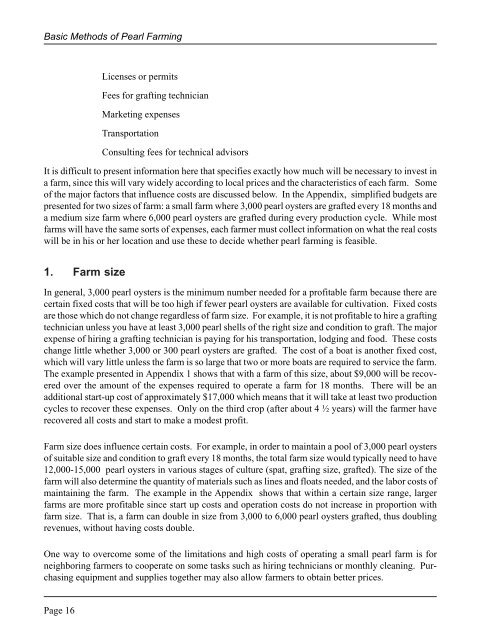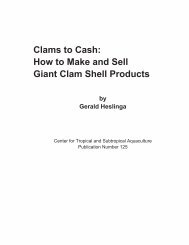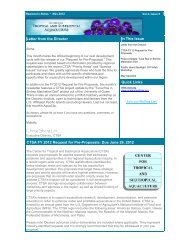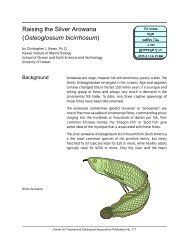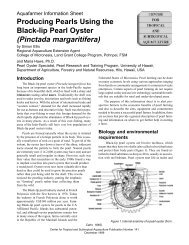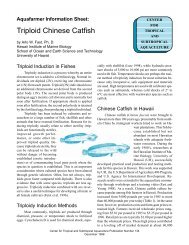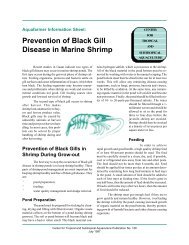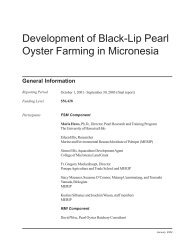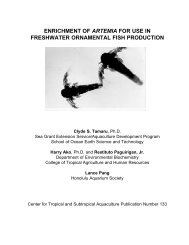The Basic Methods of Pearl Farming: A Layman's Manual - CTSA
The Basic Methods of Pearl Farming: A Layman's Manual - CTSA
The Basic Methods of Pearl Farming: A Layman's Manual - CTSA
Create successful ePaper yourself
Turn your PDF publications into a flip-book with our unique Google optimized e-Paper software.
<strong>Basic</strong> <strong>Methods</strong> <strong>of</strong> <strong>Pearl</strong> <strong>Farming</strong>Licenses or permitsFees for grafting technicianMarketing expensesTransportationConsulting fees for technical advisorsIt is difficult to present information here that specifies exactly how much will be necessary to invest ina farm, since this will vary widely according to local prices and the characteristics <strong>of</strong> each farm. Some<strong>of</strong> the major factors that influence costs are discussed below. In the Appendix, simplified budgets arepresented for two sizes <strong>of</strong> farm: a small farm where 3,000 pearl oysters are grafted every 18 months anda medium size farm where 6,000 pearl oysters are grafted during every production cycle. While mostfarms will have the same sorts <strong>of</strong> expenses, each farmer must collect information on what the real costswill be in his or her location and use these to decide whether pearl farming is feasible.1. Farm sizeIn general, 3,000 pearl oysters is the minimum number needed for a pr<strong>of</strong>itable farm because there arecertain fixed costs that will be too high if fewer pearl oysters are available for cultivation. Fixed costsare those which do not change regardless <strong>of</strong> farm size. For example, it is not pr<strong>of</strong>itable to hire a graftingtechnician unless you have at least 3,000 pearl shells <strong>of</strong> the right size and condition to graft. <strong>The</strong> majorexpense <strong>of</strong> hiring a grafting technician is paying for his transportation, lodging and food. <strong>The</strong>se costschange little whether 3,000 or 300 pearl oysters are grafted. <strong>The</strong> cost <strong>of</strong> a boat is another fixed cost,which will vary little unless the farm is so large that two or more boats are required to service the farm.<strong>The</strong> example presented in Appendix 1 shows that with a farm <strong>of</strong> this size, about $9,000 will be recoveredover the amount <strong>of</strong> the expenses required to operate a farm for 18 months. <strong>The</strong>re will be anadditional start-up cost <strong>of</strong> approximately $17,000 which means that it will take at least two productioncycles to recover these expenses. Only on the third crop (after about 4 ½ years) will the farmer haverecovered all costs and start to make a modest pr<strong>of</strong>it.Farm size does influence certain costs. For example, in order to maintain a pool <strong>of</strong> 3,000 pearl oysters<strong>of</strong> suitable size and condition to graft every 18 months, the total farm size would typically need to have12,000-15,000 pearl oysters in various stages <strong>of</strong> culture (spat, grafting size, grafted). <strong>The</strong> size <strong>of</strong> thefarm will also determine the quantity <strong>of</strong> materials such as lines and floats needed, and the labor costs <strong>of</strong>maintaining the farm. <strong>The</strong> example in the Appendix shows that within a certain size range, largerfarms are more pr<strong>of</strong>itable since start up costs and operation costs do not increase in proportion withfarm size. That is, a farm can double in size from 3,000 to 6,000 pearl oysters grafted, thus doublingrevenues, without having costs double.One way to overcome some <strong>of</strong> the limitations and high costs <strong>of</strong> operating a small pearl farm is forneighboring farmers to cooperate on some tasks such as hiring technicians or monthly cleaning. Purchasingequipment and supplies together may also allow farmers to obtain better prices.Page 16


